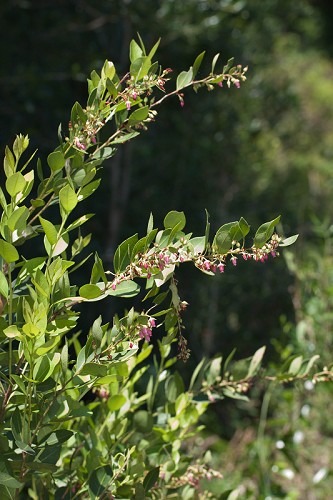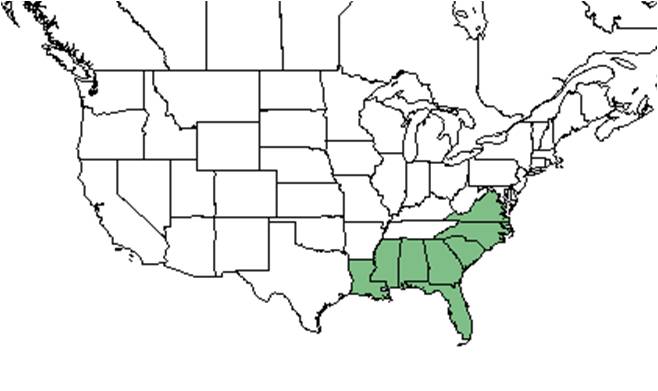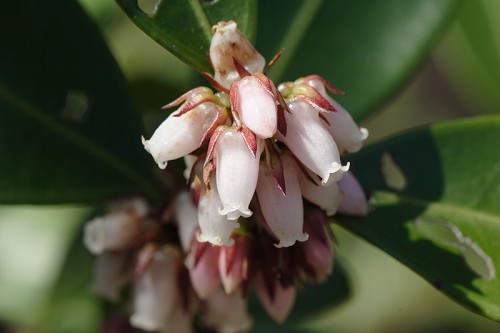Difference between revisions of "Lyonia lucida"
Juliec4335 (talk | contribs) (→Habitat) |
Emmazeitler (talk | contribs) |
||
| Line 18: | Line 18: | ||
}} | }} | ||
| − | Common names: Fetterbush lyonia; Shining fetterbush | + | Common names: Fetterbush lyonia; Shining fetterbush<ref name="weakley">Weakley, A.S. 2015. Flora of the southern and mid-atlantic states. Working Draft of 21 May 2015. University of North Carolina at Chapel Hill, Chapel Hill, North Carolina.</ref> |
==Taxonomic notes== | ==Taxonomic notes== | ||
| − | Synonyms: ''Desmothamnus lucidus'' (Lamarck) Small; ''Neopieris nitida'' (Bartram ex Marshall) Britton | + | Synonyms: ''Desmothamnus lucidus'' (Lamarck) Small; ''Neopieris nitida'' (Bartram ex Marshall) Britton.<ref name="weakley">Weakley, A.S. 2015. Flora of the southern and mid-atlantic states. Working Draft of 21 May 2015. University of North Carolina at Chapel Hill, Chapel Hill, North Carolina.</ref> |
| + | |||
| + | Varieties: none.<ref name="weakley">Weakley, A.S. 2015. Flora of the southern and mid-atlantic states. Working Draft of 21 May 2015. University of North Carolina at Chapel Hill, Chapel Hill, North Carolina.</ref> | ||
==Description== | ==Description== | ||
<!-- Basic life history facts such as annual/perrenial, monoecious/dioecious, root morphology, seed type, etc. --> | <!-- Basic life history facts such as annual/perrenial, monoecious/dioecious, root morphology, seed type, etc. --> | ||
| − | A description of ''Lyonia lucida'' is provided in [http://efloras.org/florataxon.aspx?flora_id=1&taxon_id=250065690 The Flora of North America]. | + | A description of ''Lyonia lucida'' is provided in [http://efloras.org/florataxon.aspx?flora_id=1&taxon_id=250065690 The Flora of North America]. It is distinguishable by glossy, coriaceous leaves with a prominent vein along the margins.<ref name="weakley">Weakley, A.S. 2015. Flora of the southern and mid-atlantic states. Working Draft of 21 May 2015. University of North Carolina at Chapel Hill, Chapel Hill, North Carolina.</ref> |
==Distribution== | ==Distribution== | ||
| + | ''L. lucida'' ranges from southeast Virginia to southern Florida, then west to east-central Louisiana. This species is also found in western Cuba.<ref name="weakley">Weakley, A.S. 2015. Flora of the southern and mid-atlantic states. Working Draft of 21 May 2015. University of North Carolina at Chapel Hill, Chapel Hill, North Carolina.</ref> | ||
==Ecology== | ==Ecology== | ||
===Habitat=== | ===Habitat=== | ||
| Line 32: | Line 35: | ||
<!--Natural communities, human disturbed habitats, topography, hydrology, soils, light, fire regime requirements for removal of competition, etc.--> | <!--Natural communities, human disturbed habitats, topography, hydrology, soils, light, fire regime requirements for removal of competition, etc.--> | ||
| − | ''Lyonia lucida'' is frequent and abundant in the Central Florida Flatwoods/Prairies and North Florida Wet Flatlands community types as described in Carr et al. (2010).<ref>Carr, S.C., K.M. Robertson, and R.K. Peet. 2010. A vegetation classification of fire-dependent pinelands of Florida. Castanea 75:153-189.</ref> | + | ''Lyonia lucida'' is frequent and abundant in the Central Florida Flatwoods/Prairies and North Florida Wet Flatlands community types as described in Carr et al. (2010).<ref>Carr, S.C., K.M. Robertson, and R.K. Peet. 2010. A vegetation classification of fire-dependent pinelands of Florida. Castanea 75:153-189.</ref> The habitats that it frequents include pocosins, wet woodlands, blackwater swamp forests, other acidic wetlands, especially if peaty.<ref name="weakley">Weakley, A.S. 2015. Flora of the southern and mid-atlantic states. Working Draft of 21 May 2015. University of North Carolina at Chapel Hill, Chapel Hill, North Carolina.</ref> |
===Phenology=== <!--Timing off flowering, fruiting, seed dispersal, and environmental triggers. Cite PanFlora website if appropriate: http://www.gilnelson.com/PanFlora/ --> | ===Phenology=== <!--Timing off flowering, fruiting, seed dispersal, and environmental triggers. Cite PanFlora website if appropriate: http://www.gilnelson.com/PanFlora/ --> | ||
| − | ''L. lucida'' | + | ''L. lucida'' flowers from February to early June and fruits from September through October.<ref name="weakley">Weakley, A.S. 2015. Flora of the southern and mid-atlantic states. Working Draft of 21 May 2015. University of North Carolina at Chapel Hill, Chapel Hill, North Carolina.</ref> |
<!--===Seed dispersal===--> | <!--===Seed dispersal===--> | ||
<!--===Seed bank and germination===--> | <!--===Seed bank and germination===--> | ||
| Line 41: | Line 44: | ||
===Pollination=== | ===Pollination=== | ||
| − | The following Hymenoptera families and species were observed visiting flowers of ''Lyonia lucida'' at Archbold Biological Station: <ref name="Deyrup 2015">Deyrup, M.A. and N.D. 2015. Database of observations of Hymenoptera visitations to flowers of plants on Archbold Biological Station, Florida, USA.</ref> | + | The following Hymenoptera families and species were observed visiting flowers of ''Lyonia lucida'' at Archbold Biological Station:<ref name="Deyrup 2015">Deyrup, M.A. and N.D. 2015. Database of observations of Hymenoptera visitations to flowers of plants on Archbold Biological Station, Florida, USA.</ref> |
Apidae: ''Bombus impatiens'' | Apidae: ''Bombus impatiens'' | ||
Revision as of 09:05, 28 September 2020
| Lyonia lucida | |
|---|---|

| |
| Photo by John R. Gwaltney, Southeastern Flora.com | |
| Scientific classification | |
| Kingdom: | Plantae |
| Division: | Magnoliophyta - Flowering plants |
| Class: | Magnoliopsida – Dicotyledons |
| Order: | Ericales |
| Family: | Ericaceae |
| Genus: | Lyonia |
| Species: | L. lucida |
| Binomial name | |
| Lyonia lucida (Lam.) K. Koch | |

| |
| Natural range of Lyonia lucida from USDA NRCS Plants Database. | |
Common names: Fetterbush lyonia; Shining fetterbush[1]
Contents
Taxonomic notes
Synonyms: Desmothamnus lucidus (Lamarck) Small; Neopieris nitida (Bartram ex Marshall) Britton.[1]
Varieties: none.[1]
Description
A description of Lyonia lucida is provided in The Flora of North America. It is distinguishable by glossy, coriaceous leaves with a prominent vein along the margins.[1]
Distribution
L. lucida ranges from southeast Virginia to southern Florida, then west to east-central Louisiana. This species is also found in western Cuba.[1]
Ecology
Habitat
L. lucida responds positively to soil disturbance by heavy silvilculture in North Carolina.[2] It also responds both positively and negatively to soil disturbance by clearcutting and roller chopping in North Florida.[3] However, it responds negatively to chopping in South Florida saw palmetto-pinleand communities.[4]
Lyonia lucida is frequent and abundant in the Central Florida Flatwoods/Prairies and North Florida Wet Flatlands community types as described in Carr et al. (2010).[5] The habitats that it frequents include pocosins, wet woodlands, blackwater swamp forests, other acidic wetlands, especially if peaty.[1]
Phenology
L. lucida flowers from February to early June and fruits from September through October.[1]
Pollination
The following Hymenoptera families and species were observed visiting flowers of Lyonia lucida at Archbold Biological Station:[6]
Apidae: Bombus impatiens
Halictidae: Lasioglossum placidensis
Conservation and management
Cultivation and restoration
Photo Gallery
Lyonia lucida Photo by John R. Gwaltney, Southeastern Flora.com
Flowers of Lyonia lucida Photo by John R. Gwaltney, Southeastern Flora.com
References and notes
- ↑ 1.0 1.1 1.2 1.3 1.4 1.5 1.6 Weakley, A.S. 2015. Flora of the southern and mid-atlantic states. Working Draft of 21 May 2015. University of North Carolina at Chapel Hill, Chapel Hill, North Carolina.
- ↑ Cohen, S., R. Braham, and F. Sanchez. (2004). Seed Bank Viability in Disturbed Longleaf Pine Sites. Restoration Ecology 12(4):503-515.
- ↑ Lewis, C.E., G.W. Tanner, and W.S. Terry. (1988). Plant responses to pine management and deferred-rotation grazing in north Florida. Journal of Range Management 41(6):460-465.
- ↑ Moore, W.H. (1974). Effects of Chopping Saw-Plametto-Pineland Threeawn Range in South Florida. Journal of Range Management 27(2):101-104.
- ↑ Carr, S.C., K.M. Robertson, and R.K. Peet. 2010. A vegetation classification of fire-dependent pinelands of Florida. Castanea 75:153-189.
- ↑ Deyrup, M.A. and N.D. 2015. Database of observations of Hymenoptera visitations to flowers of plants on Archbold Biological Station, Florida, USA.

